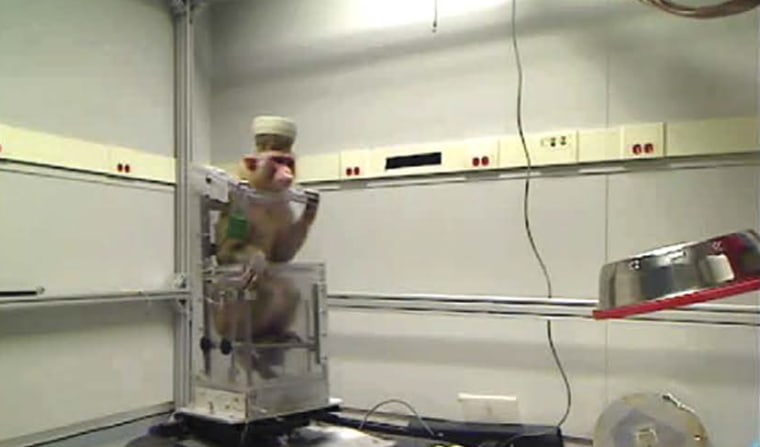Two monkeys with brain implants have steered wheelchairs using only their minds, researchers said Thursday, in another step forward for a field seeking to mobilize people with paralysis.
People have powered robotic arms with thought alone, and have controlled robotic exosketons using electrodes. And monkeys have used thought power to move objects on a computer screen. But this experiment, if it pans out for humans, would allow someone completely paralyzed to operate a wheelchair.
And the brain implants that made the mind-to-computer interface possible have lasted in the monkeys for seven years.
“This is the longest-lasting cortical brain implant ever,” Miguel Nicolelis of Duke University, who led the experiment, told NBC News.
“It has provided data to us for the whole time. It should last in humans as long or even longer,” he added. “Now we have categorical proof that these very flexible nanowires can last for a decade.”
The two monkeys rolled their wheelchairs around the lab to get themselves to a reward: a bowl of grapes.
“This is the longest-lasting cortical brain implant ever."
“Over time, monkeys improved their ability to navigate the wheelchair toward the location of a grape reward,” Nicolelis and colleagues report in the Nature journal Scientific Reports.
Nicolelis wants to try the setup to help people paralyzed by injuries or by diseases such as amyotrophic lateral sclerosis (ALS or Lou Gehrig’s disease). For them, having a brain implant would be worth the surgery and risks involved if it would get them out of bed.

He’ll need Food and Drug Administration permission to do it, but has people lined up to try.
“We have a database of a lot of patients who have written to me over the years,” Nicolelis said.
He likens the implant to a pacemaker, which can stay inside the chest for decades.
“We have a database of a lot of patients who have written to me over the years."
Nicolelis is one of several leaders in the field of brain-machine interfaces. In 2014, he staged a very public exhibition of a mind-controlled exoskeleton at the 2014 soccer World Cup competition in Brazil.
He’s also arranged for two rats — one in North Carolina, the other in Brazil — to work together using brain implants and a computer connection.
Other patients have controlled machines with their thoughts, notably Jan Scheuermann, who's been testing a device at the University of Pittsburgh and who first used her robotic arm to eat chocolate, and California’s Erik Sorto, whose three years with a brain implant have allowed him to drink beer using a robotic arm.
